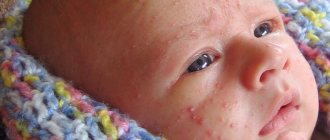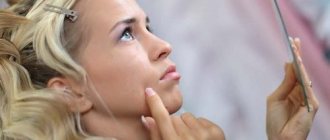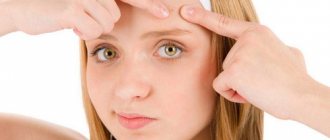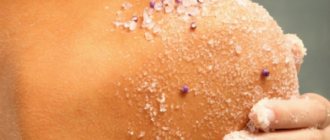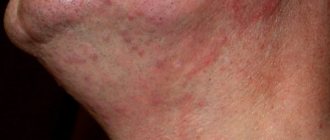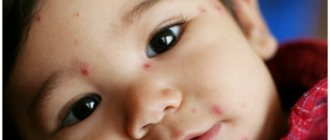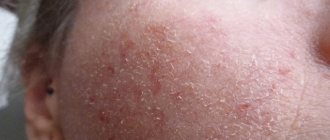In young children, in the first months of life and up to three years, the skin has increased sensitivity. For this reason, it is often covered with various rashes, spots and pimples. Often, many parents discover white pimples on their baby; they can appear on almost any part of the body, including the face.
But it is worth remembering that the appearance of these signs is the first sign of the development of pathological processes in the body. Acne in newborns can cause serious complications and severe discomfort, so you need to know the features of their manifestation and how to eliminate them.
Causes
Probably for every mother, the presence of white pimples on the face of a newborn will immediately cause great concern. Of course, this is an unpleasant phenomenon. But still, why can this defeat appear? Sometimes they can occur even with proper hygiene.
Important! Many pediatricians claim that the appearance of white pimples on the face of newborns in the first month of life is a common occurrence. Usually this process is associated with the adaptation of the child’s body to new living conditions. They go away on their own after a certain period, and there is no need to carry out certain therapeutic measures.
But you should still know the main causes of white pimples or milia in newborns. The factors of their occurrence can be different, among them the most popular are:
- hormonal changes in the child's body. Hormonal acne appears in newborns immediately after birth. These lesions are also called acne;
- increased levels of the hormone estriol. This hormone can enter the child’s body during pregnancy by the mother, but only if its level is truly elevated. Acne in newborns usually appears 3-8 days after birth. Blackheads or pimples may have a yellowish tint. They are located both individually and in groups;
- insufficient stimulation of the child’s sebaceous glands. Milia can form on the nose, cheeks, and forehead. In rare cases, the rash may cover the butt area. Sebaceous ducts often become clogged with increased levels of fat, which collects in lumps. As a result, white millet pimples can be seen on the surface of the skin. They usually disappear as the sebaceous glands mature.
Cause of pyoderma in a newborn, prevention of pustular rashes
Baby health is an important topic for every loving mother.
Mothers of newborn babies experience special experiences. Unusual symptoms make them nervous. A common occurrence is pustules on the face of a baby. Premature children and infants with weak immunity, in whom the subcutaneous fat layer has not yet fully formed, are most susceptible to them.
Because of this, wounds appear on the epidermis, into which infection enters and causes an inflammatory process.
Most pediatricians attribute the rash to non-compliance with the diet by the nursing mother. But strict adherence to nutritional rules does not always solve the problem. An allergic reaction is only one of the reasons.
Reasons for the appearance of pustules on the face of a baby
There are several reasons for the appearance of inflammation on the baby’s face:
- Hormonal rash. Occurs in more than a third of babies. The medical name is neonatal pustulosis. Among the people - flowering of newborns, acne, whiteheads, milia. Pustules appear due to the formation of hormonal levels in the baby. Through breast milk, the baby receives maternal hormones. His body is not able to absorb them, red pimples appear that change the relief of the epidermis. Sometimes there are large ulcers with white dots. They are most often located on the baby's face - on the cheeks, nose, chin, around the eyes and occurs 2-3 weeks after birth.
- Allergic reaction. In breastfed children it appears due to poor nutrition of the mother. For example, a large number of children under one year of age suffer from an allergic reaction to the protein contained in cow's milk. It can enter the baby's body through breast milk. Be careful if your family has a history of allergies to any product or medication. An allergic rash looks like red spots with a rough surface; large pimples with white heads are possible.
- Prickly heat. The delicate skin of a baby reacts to overheating with rashes all over the body. They look like red pimples with blisters. Another reason for the appearance of prickly heat is unscrupulous adherence to the rules of hygiene for the baby.
- Too intense work of the sebaceous glands. This feature of the body does not pose a threat to health. Girls are mainly affected.
- Intestinal dysbiosis. Appears due to microflora disturbance.
- Staphylococcus, streptoderma are infectious diseases.
- Infections transmitted by airborne droplets - measles, chickenpox, rubella, scarlet fever.
Pustular rashes are divided into 2 types: pathological and toxic.
Pathological causes infection. There may be an increase in temperature, red pimples, and itching. Such skin diseases can only be treated by a doctor; independent treatment can threaten the baby’s life.
Toxic rashes are a consequence of hormonal imbalance or the functioning of the sebaceous glands. Most often, they do not require treatment and go away on their own with proper care.
If you find pustules on your baby's face, be sure to consult your pediatrician.
Types of rashes that do not require medical intervention
Medical intervention is not required for the following types of rashes:
- Neonatal pustulosis (hormonal acne) caused by yeast. It goes away on its own in the first months of a baby’s life with conscientious hygienic care.
- Miliaria is a small red rash. Localized in the groin folds, neck, armpits, and face. In this case, meticulous care is required: changing the diaper every 3 hours, washing with boiled water, air baths, regular washing, and not wiping with wet wipes. The main cause of prickly heat is overheating. Carefully monitor the compliance of your baby’s clothes with the temperature conditions.
- An allergy is a small rash that often weeps and causes itching. An allergic reaction is provoked by: improper nutrition of a nursing mother, hygiene and skin care products for the baby, synthetic fabric, medications prescribed to the newborn or his mother.
Home treatment in these cases requires careful care. Wash your baby's face with boiled water twice a day. The skin of the face cannot be wiped; it is allowed to blot with a soft towel. Lubricate pimples with a decoction of string or chamomile.
Attention! Medicinal herbs can cause an allergic reaction! First you need to conduct a test - apply a couple of drops of the decoction to a small area of skin. The absence of redness and itching indicates that the herbs can be used.
Mild pathological pimples can be treated at home after consultation with a pediatrician. Usually the pediatrician prescribes antibacterial ointment. Among traditional methods, the use of Kalanchoe, rose hip, and sea buckthorn oils is allowed. If the pustules spread quickly, stop bathing for a while.
Other causes of pustules require drug treatment. If the baby has lost weight, become lethargic, or has a fever, you should call a doctor immediately. You may need a course of antibiotics. In advanced cases, treatment in a hospital.
Probable pathological diseases
The following types of possible diseases are distinguished:
- Staphylococcus aureus causes blistering rashes from 1 to 2 weeks of life. Papules with liquid sometimes reach 1-2 centimeters. When they burst, erosion occurs. The little one becomes restless. The doctor prescribes antibiotics and anti-inflammatory ointments. Lack of treatment leads to pneumonia, otitis, and abscesses.
- Intestinal dysbiosis is characterized by large pimples on the face of a baby. When the disease is eliminated, the ulcers go away on their own.
- Airborne diseases occur in children in the same way as in older children. You don’t have to leave the house to become infected; anyone can bring the infection, including the baby’s mother or father.
Types of rashes
There are different types of rashes:
- Papules are raised red pimples without contents. They cannot be opened, otherwise scars will remain. Occurs during chickenpox, staphylococcal infection.
- Pustules are voluminous pimples with a white head, indicating the presence of pus. Appear due to staphylococcus or streptococcus, hypovitaminosis, allergies, and increased sweating.
- Nodules are inflammations under the skin that cause thickening and redness of the skin. The cause is infectious diseases.
- Small pimples appear with a hormonal rash, an allergic reaction, or prickly heat.
What to eat as a mother to avoid allergic reactions in the baby
When breastfeeding, many substances from the food received by the mother's body enter the milk and enter the baby's body. They can cause allergies. The sensitivity of children is individual, so each mother makes her own diet.
According to doctors' recommendations, the diet of a nursing mother includes:
- lean meat and lean fish - 200 g;
- cottage cheese – 150 g;
- cheese – 20-30 g;
- vegetables - 600 g;
- fruits – 300 g.
- butter – 20 g;
- vegetable oil – 25 g.
Attention! Vegetables and fruits should not contain red pigment.
Once every 2 days, a nursing mother tries a new product. If the baby has no allergies and is not bothered by gases, the product can be added to the diet. If the result is negative, this food should not be consumed. Re-introduction should be postponed until the baby is 5-6 months old. By that time, the gastrointestinal tract will be stronger.
Products that can be gradually added to the diet: milk, eggs, cocoa, honey, mushrooms, nuts, carrots; later - strawberries, raspberries, currants, pomegranates, persimmons, tomatoes.
List of foods that are most often well tolerated by children: kefir, cottage cheese, yogurt, cheese, potatoes, corn, buckwheat and oatmeal, rabbit meat, lean veal, apples.
List of foods that are most often poorly tolerated by children: beans, cabbage, coffee, sausages, smoked fish, canned food, sweet carbonated drinks.
To avoid the appearance of a rash in your baby, you need to know the triggering factors. These include using baby wipes even if they are labeled as safe for newborns. The composition with which the wipes are impregnated irritates sensitive children's skin. Buy clothes made from cotton and avoid synthetics. Do not apply creams or oils to your baby's delicate skin unnecessarily.
Prevention of a rash on a baby’s face consists of daily hygiene procedures and the comfort of the baby’s environment. Air baths are required. Wash your newborn's clothes exclusively with baby powder or soap and rinse thoroughly.
Then iron clothes, towels and bed linen with a hot iron to disinfect. Sterilize pacifiers, teethers, and rattles or wash them in boiled water. The baby can be bathed in herbal decoctions. They are good antiseptics.
These include chamomile, string, oregano, celandine, bay leaf. If a wound occurs, treat the skin with hydrogen peroxide and cover the damage with a band-aid. Cut your baby's nails every week.
Dirt accumulates underneath them - this is an excellent place for germs to multiply, and the baby often puts his hands in his mouth.
Cause of pyoderma in a newborn, prevention of pustular rashes Link to main publication
Source: https://dermatologiya.su/gnoynichkovye/na-litse-u-novorozhdennogo
Spawn Locations
White pimples can appear not only on the face of a newborn; these lesions are also often found on other areas of the body. There may be acne on the baby's head, arms, back, legs, face and even in the mouth.
So why can white pimples appear on different parts of the body in a child? They can be provoked by a variety of factors that every parent should know:
- Acne in newborns often occurs on the nose in the first days after birth. This indicates hormonal changes in the body. These lesions go away on their own after a certain period of time;
- The appearance of white rashes in the mouth. Localization of acne in this area can occur for various reasons. A white pimple on a baby's gum may occur due to stomatitis. This disease is a consequence of non-compliance with the necessary oral hygiene - dirty pacifiers, nipples, feeding bottles;
- White pimples on the palate of a newborn may occur due to the presence of dysbiosis, which is caused by drug treatment. But only the attending physician can determine the exact cause after a complete examination of the child;
- White pimples on the face of a newborn, namely on the cheeks, can appear due to unstable functioning of the sebaceous glands. Usually these phenomena disappear within a month after birth.
What causes pustular rash in babies
Baby health is an important topic for every loving mother. Mothers of newborn babies experience special experiences. Unusual symptoms make them nervous. A common occurrence is pustules on the face of a baby.
Premature children and infants with weak immunity, in whom the subcutaneous fat layer has not yet fully formed, are most susceptible to them.
Because of this, wounds appear on the epidermis, into which infection enters and causes an inflammatory process.
Most pediatricians attribute the rash to non-compliance with the diet by the nursing mother. But strict adherence to nutritional rules does not always solve the problem. An allergic reaction is only one of the reasons.
Why do red rashes appear?
Not only can a child develop white pimples, but a red rash is also common. Sometimes red lesions can be combined with white ones. So why might they occur?
Important! A common cause of red acne is allergic reactions. Allergies can occur to various foods that a nursing mother has eaten. The child may also experience side effects from the components of baby food.
So how can you identify which product your child is allergic to?
- first of all, a nursing mother should keep a special diary;
- All the food she eats should be recorded in a diary;
- In addition to the type of food, it is imperative to record the time of meal and what food was eaten during this period.
White spots in an infant
Tiny white dots on a baby's skin are a very common occurrence. Small pimples are called milia; they are most often localized on the nose, but can also be found on the forehead or cheeks. The main reason for their appearance is blockage of the sebaceous ducts, which, in turn, is caused by insufficient maturity of the sebaceous glands.
Whiteheads disappear from a child’s skin in just a few weeks, and parents are advised to:
- Care for your baby as usual.
- Do not overheat the baby excessively.
- Do not lubricate milia with any creams, ointments, or especially medications.
- Do not try to squeeze out the white dots, pick them up or remove them with a washcloth, etc.
If you try to get rid of milia mechanically, this will not speed up the process of eliminating them, but will bring discomfort to the baby and also increase the risk of infection.
Other types of acne
Newborns up to one year old often develop various types of acne, spots, and moles. However, they cannot always be painted pure white or red. If prickly heat or hormonal rashes are a natural manifestation in babies in their first days of life, then other lesions that cause various diseases are much more serious and dangerous.
So what lesions can be a consequence of diseases:
- Small purulent pimples on the face appear as a result of a disease such as vesiculopustulosis. They can occur on almost any part of the body, even on a child’s head. The provoking cause is the presence of a staphylococcal infection. These lesions are treated with brilliant green or a strong solution of potassium permanganate. The help of a specialist is required;
- Pimples with a vesicular structure and a red halo. These types of formations indicate the presence of herpes or chickenpox;
- Spots with rashes occur during measles, rubella, scarlet fever, allergies;
- The presence of red pimples with a white tip is the main sign of furunculosis.
Differences between neonatal and allergic rashes
A small hormonal rash in a baby resembles an allergy. However, these conditions have differences from each other. They are as follows:
- Allergies cause itching and flaking of the skin.
- Neonatal acne is similar to teenage acne.
- An allergic reaction occurs abruptly after contact with an allergen, and pustules gradually appear as small rashes in different places.
- Acne does not cause discomfort in the child. The rash goes away in one place and appears in another.
- Red nodular dots are localized only in the head area, the allergy spreads throughout the body.
- If you have an allergy, your baby will try to scratch the area with the rash.
Neonatal pustulosis does not cause any concern in children; they continue to eat, sleep and develop normally. During allergies, babies become capricious, itching prevents them from sleeping and eating. To verify your assumptions, you should consult your pediatrician.
READ ALSO: After a massage, a rash on the back, face and legs: what to do if acne appears? |
Important! The hormonal rash is not always full inside; sometimes it is visually invisible and appears as roughness on the face.
Features of treatment
If white pimples appear on a baby's face, then in these cases there is no particular cause for concern. They arise due to hormonal changes in the body. Over time, the baby’s condition will normalize, and the white acne will disappear by itself.
Important! You can’t squeeze pimples or pick them off. As a result, this can cause severe damage to the surface layers of the skin, cause infection, and leave scars.
If acne on the face of an infant causes severe discomfort and unpleasant sensations, then at home you can do the following to alleviate the condition:
- the child needs to be washed 2-3 times a day with warm boiled water;
- the baby needs to be bathed in a weak solution of potassium permanganate;
- You can use baths with a decoction of the string for bathing. This herb has a beneficial effect on the baby’s sensitive skin, improves its structure;
- you can wipe your face and affected areas of the skin with a decoction of string or chamomile;
- maintain baby skin hygiene - use powder, sanitary napkins, baby cream, regular bathing.
But still, if you suspect the development of an unhealthy process and see your baby has severe rashes on the face, butt, back, legs and other parts of the body, then you should immediately consult a doctor. Only a doctor can carry out the necessary examination and treatment. You should not self-medicate, as this can cause serious harm to the baby.
